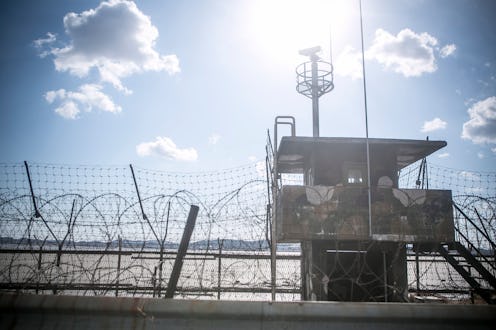News
Everything You Need To Know About The Stretch Of Land That Splits North & South Korea

President Donald Trump revealed on Twitter Sunday that he had sent a team from Washington to the Korean peninsula for a meeting in the demilitarized zone ahead of what would be a historical summit between the United States and North Korea. That particular area is as close as any outsider will get to North Korea, and the significance behind where the DMZ is in Korea is rooted in its history and how it came to be.
The DMZ is a border demarcating the territory between North and South Korea. It's an east-to-west line that stretches across the entirety of the approximately 160-mile Korean peninsula, and within it is Panmunjom, the "truce village" where American diplomats are meeting North Korean officials. The approximately 2.5 mile wide demilitarized zone was created in 1953 as part of the Korean Armistice Agreement to end the Korean War and originally meant to be used as a ceasefire until a "final peaceful settlement" could be found, according to TIME. Now, that settlement finally seems to be within reach as North Korea, South Korea, and the United States look toward a possible summit.
But until then, the DMZ continues to act as a neutral cushion between the two nations. Neither side can use weapons or do anything inside the zone that could be construed as an act of aggression. And though North and South Korea showed their solidarity during the 2018 Winter Olympics, the DMZ is a 65-year-old tangible reminder that the two countries are worlds apart.
While the zone itself is a no-fighting-no-escalation zone, the immediate areas outside of it are anything but. Both sides flex their military might, and hard. According to Wired, the barren land surrounding the DMZ is dotted with mines and watch stations occupied by armed soldiers. Both are incredibly fortified with military personnel and weapons. The U.K.'s Independent described a "double line of tall, chainlink fences topped with razor wire" with rows of bunkers guarded by North Korean sentinels in mirrored sunglasses along the border. And there's the matter of the expression on your face — the Independent reporter who traveled to the DMZ was told she could not engage or provoke the North Korean troops, nor could she laugh, joke, or gesture. On the South Korean side stand the same sort of heavily-armed soldiers. But unlike North Korea, South Korea has an additional assault weapon: the South side has been blasting bubbly K-pop music and anti-communist propaganda across the border for the past two years. In April, the South Korean government stopped the music to reduce "military tensions between the South and North" and create "a mood for peaceful talks" ahead of the summit, according to USA Today.
Still, as is natural in any capitalist society, there is money to be made along the DMZ. The South Korean side offers tours along the border but, of course, nowhere past it. Surprisingly, North Korea used to allow bus tours with South Korean citizens into its territory to visit one of its mountain landmarks, Geumgangsan, according to The Guardian. South Korean guests would stay in a resort on North Korean land. However, as the Guardian reported, that gesture of goodwill was revoked after a North Korean soldier shot a South Korean tourist dead in 2008 for wandering into a restricted area of the resort. Business has not stopped though. People sell souvenirs from North Korea on the South side, and according to TIME, the South Korean government is currently building a large observatory tower, slated to open in the summer, that will let visitors peek into North Korea.
If this summit goes as planned and both Koreas find the peace that has eluded them for decades, the DMZ might fade into the past. But before anything else, we'll have to wait to see whether this summit will ever happen.